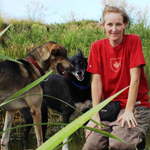In the basic obedience classes I teach as a dog trainer, I don’t spend hours training the dogs to heel. I don’t even spend much time on loose-leash walking as a trained behavior. I simply direct my students to the smorgasbord of anti-pull gear at the local pet store (front-clip harnesses and head halters), and move on to other items on the curriculum, like safety recalls, jumping up, and leave-it.
It’s not that training dogs to heel isn’t fun–it certainly can be, if we toss the out-moded leash-pop and use a modern training plan. But few of my students actually care about their dog’s ability to heel. What they want is a dog who won’t send them to the hospital with a shoulder injury.
And when I have explored the desire-to-heel phenomenon with the few students who do push for it, it seems to be a stand-in for control. Their large, young dogs are unruly, mouthing everyone, barking at the window, and jumping on the table; embarrassing, and even a bit scary. The image of the dog trotting subserviently just behind them provides some longed-for if imaginary relief. I’ve had young and boisterous dogs, too, so I get it.
Loose-leash walking on cue is certainly handy for many dogs in many scenarios, so a lot of trainers rightfully decide that it is worth a bigger piece of their class curriculum pie. However, for my basic classes in the semi-rural area I teach, I always come clean with my students: I have an agenda. I want their dog not to heel. I want walks to be about enrichment of the most delightful, nose-to-the-grass scent-filled way possible. I want walks to be sniffaris.
Walks as Enrichment
Humans tend to walk slowly compared to their dog’s normal, unleashed, gait. So although a leash walk might be reasonable exercise for elderly or small dogs, the adolescent goobers in my classes need separate and athletic exercise to tire out their bodies. Leash walks are instead a great way to tire out their minds. On a leash walk, a dog is checking out his world, drinking it all in through a miasma of odors: who went by? When? Which way? Oh, was there a squirrel there? There was. What else? What else? What else? When your dog has nose to the ground or is …’depositing’ his own smell, you can imagine that he is enjoying himself in the same way that you enjoy catching up with old friends on Facebook. Or, you know, watching kitten videos: no shame.
Enrichment has been a hot topic among dog owners and professionals recently, and for good reason. It’s simply humane to provide enrichment for dogs, like toys, chews, games, and more. But not unimportantly, enrichment can help to tire out your dog, and prevent them from enriching themselves‒with your stair rails, your laundry, or your favorite shoes.
So, join the sniffari movement with your dog. Next time you head out on a walk, let them sniff to their heart’s content. Plan your route to include new and exciting scents, or to the extent possible and safe, give them the option to lead you around. Cue up an audiobook or a new album and feel free to linger with your dog when they pause for a few extra sniffs at the local fire hydrant. They might just need a bit of time to like another dog’s post.
 Kristi Benson
Kristi Benson
Kristi Benson is an honours graduate of the prestigious Academy for Dog Trainers, where she earned her Certificate in Training and Counseling (CTC). She lives and works in the Parkland Region of central Manitoba Canada, where she teaches dog obedience classes and helps dog owners in private consultations – both in-person and via video chat – for a full range of dog problems, from basic obedience to aggressive behaviour. Kristi is on staff at the Academy for Dog Trainers, helping to shape the next generation of canine professionals. Kristi’s dogs are rescue sled dogs, and for fun she runs them with a dog-powered scooter and on skis. Contact her through her website, and check out her blog, Facebook page, or Twitter for training tips, articles about dogs and training, and more.




 Kristi Benson
Kristi Benson


